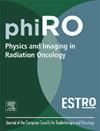Evaluation and tuning of a commercial automated planning system for prostate radiotherapy
IF 3.3
Q2 ONCOLOGY
引用次数: 0
Abstract
Background and Purpose:
Artificial Intelligence (AI) based automated planning is increasing in popularity. Guidance has been published recommending approaches for the safe implementation and monitoring of these techniques. An evaluation of a commercial AI tool was undertaken and reported along with the specific methods used to evaluate, tune and monitor the plan quality.
Materials and Methods:
A total of 335 previously planned prostate patients were used to evaluate and commission a commercial AI based planning solution. The quality of the automatically produced plans was compared to previous practice using models inspired by existing research into knowledge based planning. A quantile regression based technique identified the most optimal historic plans to be used for model tuning. Finally, a control chart based method was validated for post-deployment monitoring of the produced plan quality.
Results:
The baseline model provided by the manufacturer was found to provide good plan quality overall with 9 out 15 plan quality metrics found to have lower variance after accounting for anatomy. Rectum sparing was found to be inferior to human generated plans. Two further iterations of the model were produced in collaboration with the manufacturer. Further iterations of the model resulted in comparable rectum sparing, a 0.02 mean difference in rectum V50 Gy, was achieved whilst maintaining much of the improved consistency.
Conclusions:
A method to implement the guidance for commissioning of automated and AI based planning tools is presented alongside a method for monitoring the subsequent plan quality. The final plan quality achieved was comparable to or better than the original plans following two revisions.

商用前列腺放射治疗自动化计划系统的评估与调整
背景与目的:基于人工智能(AI)的自动化规划越来越受欢迎。已经发表了指南,建议安全实施和监测这些技术的方法。对商业人工智能工具进行了评估,并报告了用于评估、调整和监控计划质量的具体方法。材料与方法:共使用335名先前计划的前列腺患者来评估和调试基于人工智能的商业计划解决方案。利用现有的基于知识的规划研究启发的模型,将自动生成的计划的质量与以前的实践进行了比较。基于分位数回归的技术确定了用于模型调优的最优历史计划。最后,验证了一种基于控制图的生产计划部署后质量监控方法。结果:制造商提供的基线模型总体上提供了良好的计划质量,在考虑解剖后,15个计划质量指标中有9个具有较低的方差。直肠节约被发现不如人类产生的计划。该模型的两个进一步迭代是与制造商合作生产的。模型的进一步迭代产生了相当的直肠节约,直肠V50 Gy的平均差异为0.02,同时保持了大部分改进的一致性。结论:本文提出了一种实施自动化和基于人工智能的规划工具调试指导的方法,以及一种监控后续计划质量的方法。经过两次修改后,最终方案的质量与原方案相当或更好。
本文章由计算机程序翻译,如有差异,请以英文原文为准。
求助全文
约1分钟内获得全文
求助全文
来源期刊

Physics and Imaging in Radiation Oncology
Physics and Astronomy-Radiation
CiteScore
5.30
自引率
18.90%
发文量
93
审稿时长
6 weeks
 求助内容:
求助内容: 应助结果提醒方式:
应助结果提醒方式:


